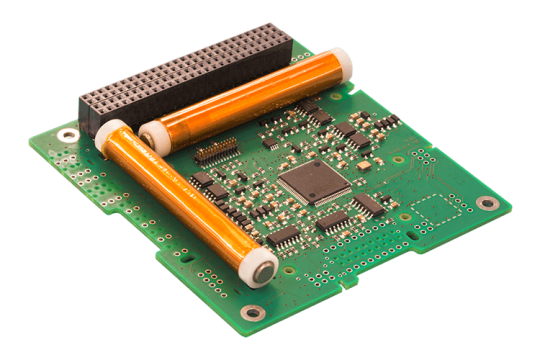
Magnettorquer
Ein Magnettorquer, auch als magnetisches Torquer oder Magnetspule bekannt, ist ein Gerät, das verwendet wird, um die Ausrichtung eines Satelliten oder Raumfahrzeugs zu steuern, indem es ein magnetisches Feld erzeugt. Dieses Magnetfeld interagiert mit dem Erdmagnetfeld, um ein Drehmoment zu erzeugen, das es dem Satelliten ermöglicht, seine Lage zu ändern, ohne Treibstoff oder mechanische bewegliche Teile zu verwenden. Magnettorquer werden häufig in kleinen Satelliten, wie CubeSats und Nanosatelliten, eingesetzt, da sie einfach, zuverlässig und kostengünstig sind.
Funktionsweise eines Magnettorquers
Magnettorquer bestehen aus elektromagnetischen Spulen oder magnetischen Stäben, die ein magnetisches Dipolmoment erzeugen, wenn elektrischer Strom durch sie fließt. Dieses magnetische Dipolmoment interagiert mit dem Erdmagnetfeld, wodurch gemäß der Rechtshandregel ein Drehmoment erzeugt wird, das den Satelliten dreht. Durch die sorgfältige Steuerung der Richtung und Stärke des Stroms in den Spulen kann die Orientierung des Satelliten kontrolliert angepasst werden.
Das von einem Magnettorquer erzeugte Drehmoment wird durch die Gleichung beschrieben:
T=M×B\mathbf{T} = \mathbf{M} \times \mathbf{B}T=M×B
wobei:
- T\mathbf{T}T das erzeugte Drehmoment ist,
- M\mathbf{M}M das vom Magnettorquer erzeugte magnetische Moment ist,
- B\mathbf{B}B das Erdmagnetfeld ist.
Arten von Magnettorquern
-
Magnetspulen (Torque Rods): Diese bestehen typischerweise aus zylindrischen Stäben, die mit einem Draht umwickelt sind. Wenn Strom durch die Spule fließt, wird ein Magnetfeld entlang der Länge des Stabs erzeugt. Torque Rods sind einfach, leicht herzustellen und bieten ein moderates Drehmoment, was sie für kleine und mittelgroße Satelliten geeignet macht.
-
Magnetische Torquer-Stäbe: Diese sind feste magnetische Stäbe, die ein Magnetfeld erzeugen, wenn ein elektrischer Strom durch sie fließt. Torquer-Stäbe sind stabiler als Spulen und können ein stärkeres Magnetfeld erzeugen, wodurch sie ein höheres Drehmoment für größere Satelliten bieten.
-
Luftkern-Magnettorquer: Diese Magnettorquer verwenden Spulen ohne magnetischen Kern und verlassen sich auf den Luftkern, um ein Magnetfeld zu erzeugen. Obwohl sie weniger Drehmoment im Vergleich zu kernbasierten Magnettorquern erzeugen, sind sie leichter und besser geeignet für sehr kleine Satelliten, bei denen die Masse ein entscheidender Faktor ist.

Anwendungen von Magnettorquern
-
Lagekontrolle: Die Hauptanwendung von Magnettorquern ist die Lagekontrolle bei Satelliten. Durch die Anpassung des von den Magnettorquern erzeugten Magnetfelds kann sich der Satellit im Weltraum orientieren, um beispielsweise Solarzellen zur Sonne auszurichten, Antennen auf die Erde zu richten oder seine Ausrichtung zu stabilisieren.
-
Desaturierung von Reaktionsrädern: Magnettorquer werden häufig in Kombination mit Reaktionsrädern verwendet, die ein weiteres Mittel zur Lagekontrolle darstellen. Im Laufe der Zeit können Reaktionsräder einen Drehimpuls akkumulieren, der zur Aufrechterhaltung der Kontrolle abgebaut werden muss. Magnettorquer bieten eine Methode, den überschüssigen Drehimpuls durch Anlegen eines gegenwirkenden Drehmoments abzubauen.
-
De-Orbiting kleiner Satelliten: In einigen Fällen können Magnettorquer verwendet werden, um eine kontrollierte Taumelbewegung oder eine bestimmte Ausrichtung zu induzieren, um den De-Orbit-Prozess kleiner Satelliten zu unterstützen, was den Wiedereintritt erleichtert und das Risiko von Weltraummüll reduziert.
-
Magnetfeldmessung und Wissenschaft: Magnettorquer können auch in wissenschaftlichen Missionen verwendet werden, bei denen es erforderlich ist, die Ausrichtung des Satelliten relativ zum Erdmagnetfeld für Magnetfeldmessungen oder andere wissenschaftliche Experimente zu steuern.
Vorteile von Magnettorquern
- Treibstofffreie Bedienung: Magnettorquer benötigen keinen Treibstoff, was sie zu einer treibstofffreien Option für die Lagekontrolle macht. Dies verlängert die Missionsdauer und senkt die Betriebskosten.
- Niedriger Stromverbrauch: Sie benötigen in der Regel wenig elektrische Leistung, was sie für kleine Satelliten mit begrenztem Energiebudget geeignet macht.
- Einfachheit und Zuverlässigkeit: Magnettorquer haben keine beweglichen Teile, was ihre Zuverlässigkeit erhöht und die Wahrscheinlichkeit eines mechanischen Ausfalls verringert.
- Kompakt und Leicht: Diese Geräte sind relativ klein und leicht, was für kleine Satellitenmissionen von Vorteil ist, bei denen Platz und Gewicht begrenzt sind.
Einschränkungen von Magnettorquern
- Begrenzte Drehmomentkapazität: Magnettorquer bieten im Vergleich zu anderen Methoden der Lagekontrolle, wie etwa Triebwerken oder großen Reaktionsrädern, weniger Drehmoment, was sie für größere Satelliten oder solche, die schnelle Manöver erfordern, weniger geeignet macht.
- Abhängigkeit vom Erdmagnetfeld: Ihre Wirksamkeit nimmt mit zunehmendem Abstand von der Erde ab, da die Stärke des Erdmagnetfelds abnimmt, wodurch ihr Einsatz auf erdnahe Umlaufbahnen beschränkt wird.
- Unidirektionale Kontrolle: Magnettorquer können nur Drehmomente senkrecht zum Erdmagnetfeld erzeugen, was die Manövrierfähigkeit je nach Umlaufbahn und Orientierungsanforderungen des Satelliten einschränken kann.
Magnettorquer sind ein vielseitiges und effizientes Werkzeug zur Lagekontrolle von Satelliten, insbesondere für kleine Satelliten und CubeSats in niedrigen Erdumlaufbahnen. Ihre Einfachheit, Zuverlässigkeit und treibstofffreie Bedienung machen sie zu einer attraktiven Option für viele Weltraummissionen. Obwohl sie einige Einschränkungen in Bezug auf die Drehmomenterzeugung und die Abhängigkeit vom Erdmagnetfeld haben, machen ihre Vorteile sie zu einer beliebten Wahl für eine Vielzahl von Anwendungen in der Satellitentechnologie.